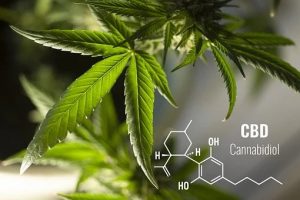Written by Joyce Smith, BS. Three consecutive days of oral cannabidiol (CBD) solution significantly reduced cravings and anxiety induced by drug cues in people with heroin use disorder who were abstinent from the drug.
 The availability of prescription opioids and heroin use within the past decade has led to an unprecedented crisis in the United States. More than 300,000 opioid-related deaths during the past decade 1 have contributed to more than four million years of life lost globally 2 and since 2007 has contributed to an increase in excess of 3,000 percent in medical services needed for patients with opioid use or misuse. This has led to a substantial economic burden 3. Previous preclinical work by Dr. Hurd and her lab team at Mount Sinai was done on animals with a history of heroin self-administration. The work demonstrated that CBD reduced the animals’ tendency to use heroin in response to a drug-associated cue. To determine whether the preclinical work could be translated to humans, her lab then conducted a series of clinical studies demonstrating that CBD was safe and tolerable in humans.
The availability of prescription opioids and heroin use within the past decade has led to an unprecedented crisis in the United States. More than 300,000 opioid-related deaths during the past decade 1 have contributed to more than four million years of life lost globally 2 and since 2007 has contributed to an increase in excess of 3,000 percent in medical services needed for patients with opioid use or misuse. This has led to a substantial economic burden 3. Previous preclinical work by Dr. Hurd and her lab team at Mount Sinai was done on animals with a history of heroin self-administration. The work demonstrated that CBD reduced the animals’ tendency to use heroin in response to a drug-associated cue. To determine whether the preclinical work could be translated to humans, her lab then conducted a series of clinical studies demonstrating that CBD was safe and tolerable in humans.
In this randomized, double-blind, placebo -controlled exploratory study 4 conducted at Mount Sinai Beth Israel Hospital in New York, researchers examined whether CBD, a nonintoxicating phytocannabinoid, could reduce cue-induced craving and anxiety (critical features of addiction that often affect relapse and continued drug use) in 42 heroin-abstinent people who had been using heroin for approximately thirteen years. Most of the participants (64%) had been abstinent from heroin for less than one month; 14% for 1-2 months and 21% for 2-3 months.
The forty-two participants, 21-50 years of age and in good health, received a once- daily dose of either 400 mg or 800 mg of oral CBD solution, or a placebo solution for 3 consecutive days. They were exposed to neutral and drug-related cues in three sessions: immediately after dosing, 24 hours after dosing, and 7days after the final dosing day. Neutral cues were a 3-minute video of relaxing scenes of nature; drug-related cues consisted of a 3-minute video of intravenous or intranasal drug use and exposure to heroin-related paraphernalia such as syringes, rubber ties and packets of powder resembling heroin.
There was no difference between the groups in their baseline craving scores; however, women reported nearly a twofold greater craving than men. Compared to the control group who experienced increased craving scores during heroin cues, the craving scores in both CBD groups (400 and 800 mg of CBD) were significantly reduced during the heroin cues but were unchanged during the neutral cues. The reduced cravings were most prominent 1 to 2 hours after the initial administration of CBD. Heroin cues not only increased cravings but increased physiological measures of stress reactivity as well: heart rate, blood pressure and cortisol levels were elevated but were all reduced by CBD. Craving and anxiety remained diminished even a week after the last CBD dose was administered.
These results replicate the pilot study done by the Hurt team and validate their animal models. The potential of CBD to reduce cue-induced craving and anxiety, in addition to its safety profile, low mortality risk and lack of addiction tendencies make this phytocannabinoid a potential treatment for the existing opioid crisis. Dr. Hurd, the lead author, states that “the specific effects of CBD on cue-induced drug craving and anxiety are particularly important in the development of addiction therapeutics because environmental cues are one of the strongest triggers for relapse and continued drug use”.
The study found no significant effects on cognition and no serious adverse events.
Source: Hurd, Yasmin L., Sharron Spriggs, Julia Alishayev, Gary Winkel, Kristina Gurgov, Chris Kudrich, Anna M. Oprescu, and Edwin Salsitz. “Cannabidiol for the Reduction of Cue-Induced Craving and Anxiety in Drug-Abstinent Individuals With Heroin Use Disorder: A Double-Blind Randomized Placebo-Controlled Trial.” American Journal of Psychiatry (2019): appi-ajp.
Posted September 23, 2019.
Joyce Smith, BS, is a degreed laboratory technologist. She received her bachelor of arts with a major in Chemistry and a minor in Biology from the University of Saskatchewan and her internship through the University of Saskatchewan College of Medicine and the Royal University Hospital in Saskatoon, Saskatchewan. She currently resides in Bloomingdale, IL.
References:
- CDC. CDC Wonder Database. 2018; CDC WONDER — Wide-ranging Online Data for Epidemiologic Research — an easy-to-use, menu-driven system that makes the information resources of the Centers for Disease Control and Prevention (CDC) available to public health professionals and the public at large. It provides access to a wide array of public health information. . Available at: https://wonder.cdc.gov/. Accessed September 18, 2019.
- Gomes T, Greaves S, Tadrous M, Mamdani MM, Paterson JM, Juurlink DN. Measuring the burden of opioid-related mortality in Ontario, Canada. Journal of addiction medicine. 2018;12(5):418.
- Health F. The Impact of the Opiod Crisis on the Healthcare System. 2016.
- Hurd YL, Spriggs S, Alishayev J, et al. Cannabidiol for the Reduction of Cue-Induced Craving and Anxiety in Drug-Abstinent Individuals With Heroin Use Disorder: A Double-Blind Randomized Placebo-Controlled Trial. American Journal of Psychiatry. 2019:appi. ajp. 2019.18101191.
